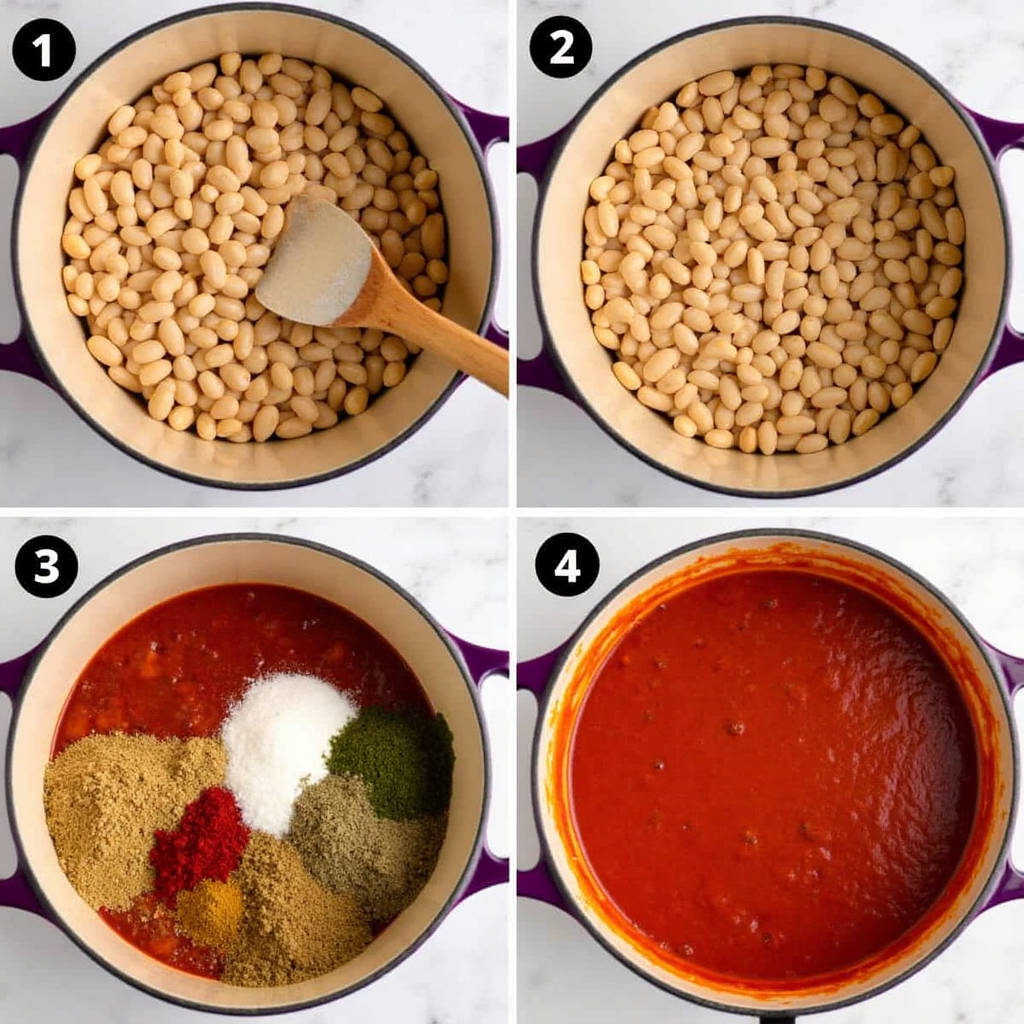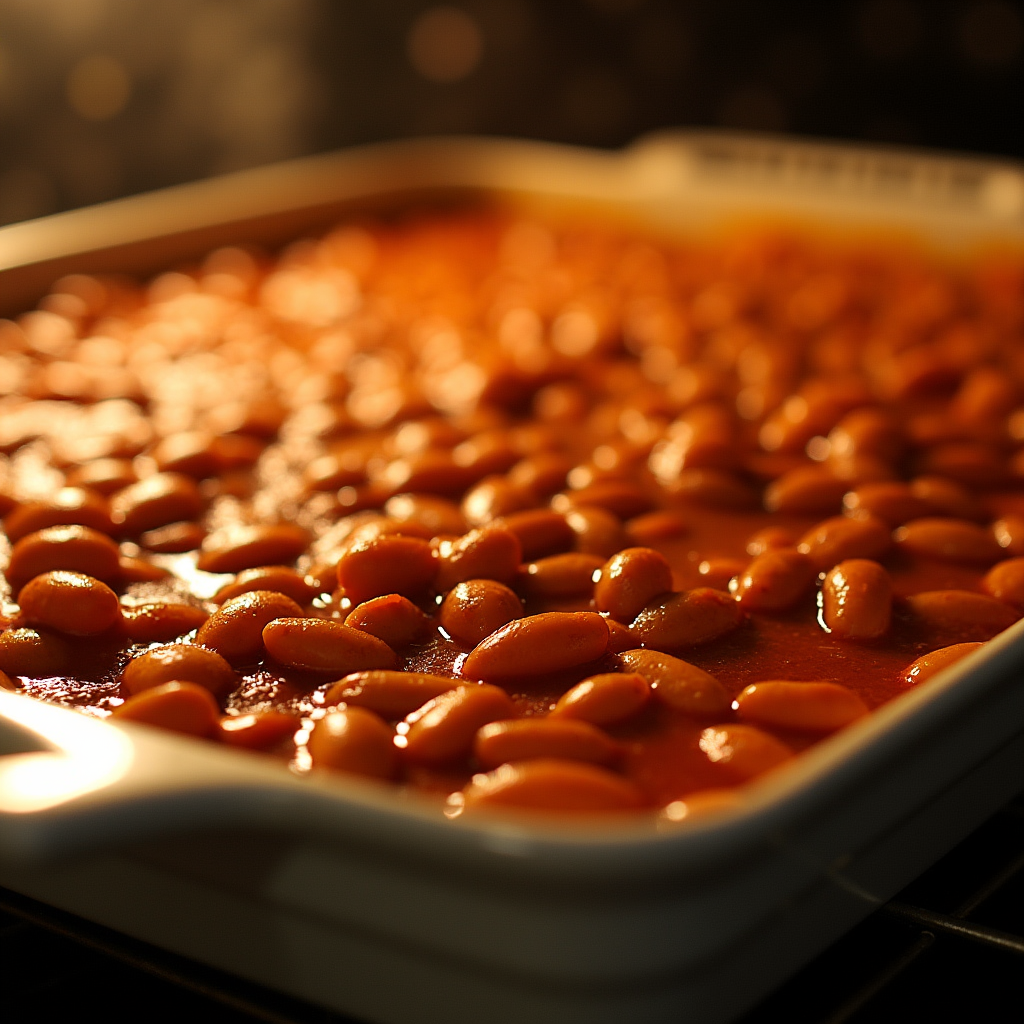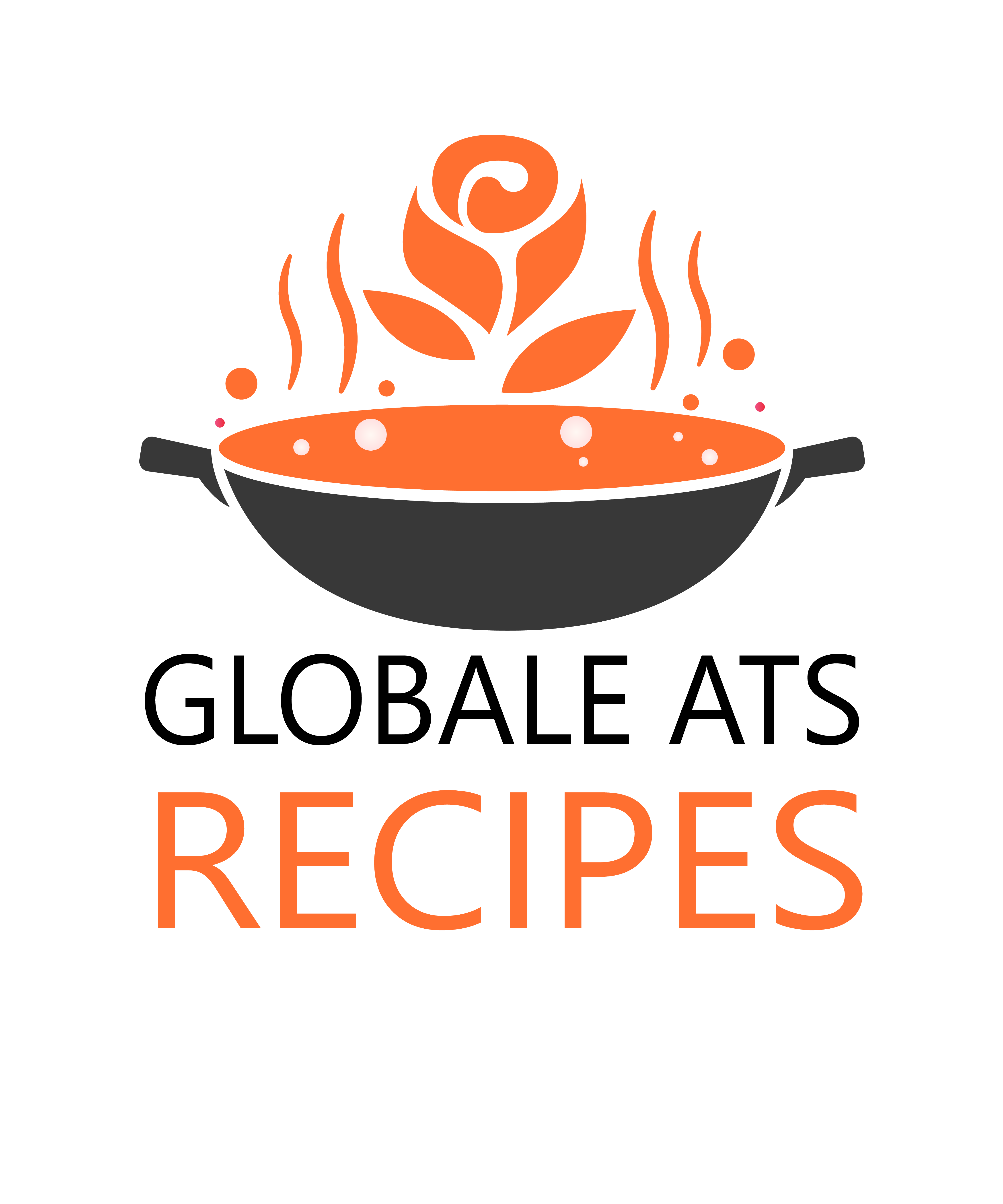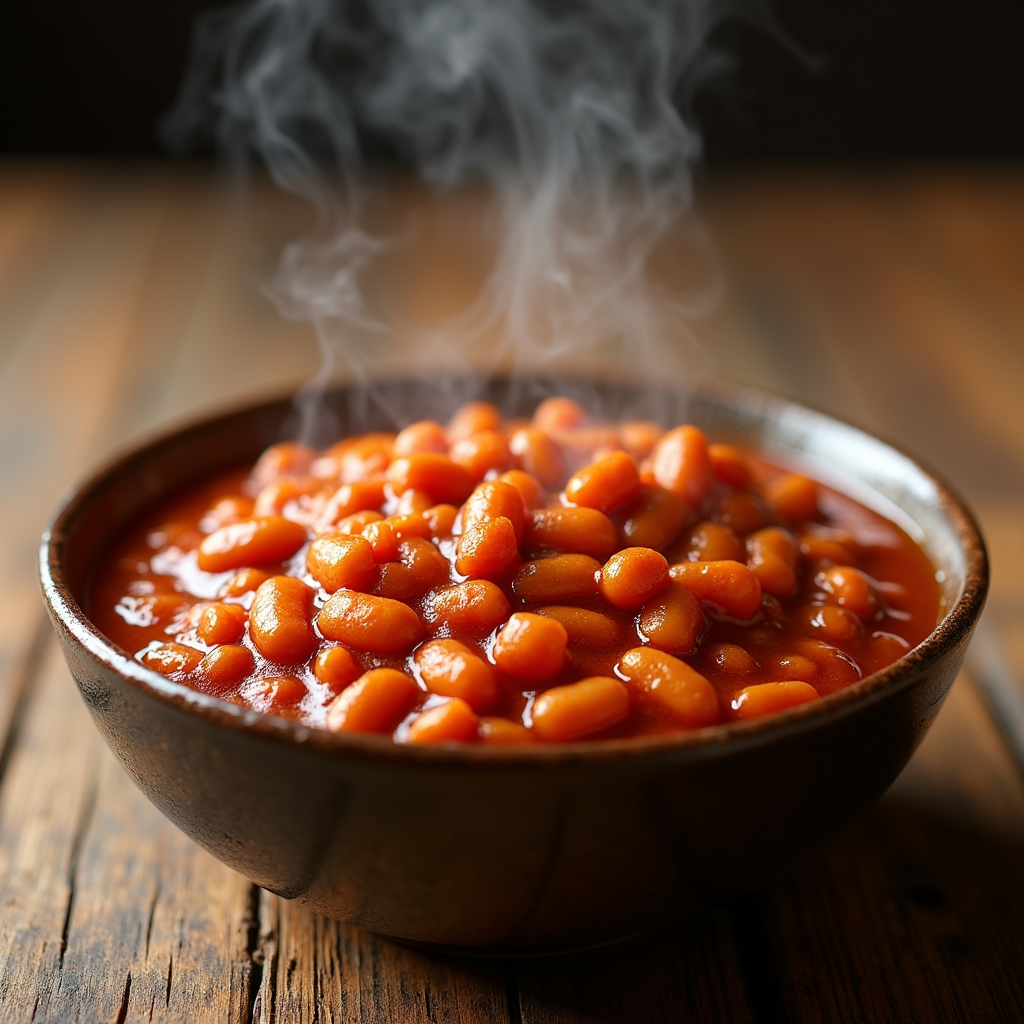How Are Baked Beans Made?
Introduction to Baked Beans
- What Are Baked Beans?
- The History and Origin of Baked Beans
Ingredients in Baked Beans
- The Role of Beans in Baked Beans
- Common Sauces Used in Baked Beans
- Spices and Flavorings
The Process of Making Baked Beans
- Preparing the Beans
- Cooking and Baking Techniques
- How Long to Bake Beans?
How Baked Beans Are Produced in Factories
- Industrial Production of Baked Beans
- From Bean to Canned Baked Beans
Variations of Baked Beans
- Regional Differences in Baked Beans
- Popular Recipes and Styles
Health Benefits and Nutritional Value of Baked Beans
- Are Baked Beans Healthy?
- The Nutrients Found in Baked Beans
Common Mistakes to Avoid When Making Baked Beans
- Overcooking the Beans
- Using the Wrong Beans for Baking
Frequently Asked Questions (FAQs)
- Can I Make Baked Beans Without Sugar?
- How Do I Store Leftover Baked Beans?
- Can I Use Dried Beans for Baking Beans?
- How Long Do Baked Beans Last in the Fridge?
Conclusion
- Summarizing the Art of Making Baked Beans
- Final Thoughts on Homemade vs. Store-Bought Baked Beans
People Also Ask (PAA):
- “How long do you bake beans?”
- “Can I make baked beans from scratch?”
- “What is the best way to cook baked beans?”
- “Why are baked beans so popular?”
LSI and NLP Keywords:
- Homemade baked beans
- Cooking baked beans
- Baked beans recipe
- Best beans for baked beans
- Canned baked beans
- Nutritional value of beans
- Baking beans from dried beans
- Classic baked beans
- Vegetarian baked beans
- Spicy baked beans
- How to cook beans
- Beans in tomato sauce
- Bean casserole
- Slow cooker baked beans
- Baking beans with pork
- Health benefits of beans
This structure should provide a detailed, informative guide that meets SEO best practices while maintaining readability for users. Would you like me to help you further with developing this content, or provide any additional sections?
How Are Baked Beans Made?
Baked beans are a comfort food classic enjoyed in various forms across the globe. They come in many varieties, from sweet and tangy to smoky and savory, depending on the recipe or region. But have you ever wondered exactly how baked beans are made? From selecting the right beans to choosing the perfect seasoning, the process of making baked beans is quite simple yet fascinating. This article will guide you through the step-by-step process of making baked beans, explore different ingredients, and offer some tips for the best results.
Now, let’s dive into the first part and explore what exactly baked beans are and where they came from.
Introduction to Baked Beans
What Are Baked Beans?
Baked beans are a popular dish made primarily from beans (often navy or kidney beans), slow-cooked in a rich sauce. Typically, the sauce is a mixture of tomato paste, molasses, brown sugar, and a variety of spices, giving it a sweet and savory flavor profile. It’s a dish that can be served as a side, a snack, or even as a hearty main course in some cultures.
The traditional recipe for baked beans involves baking them in an oven, but modern methods include slow cookers and stovetop variations. Whether you like your beans to have a sweet, tangy, or smoky flavor, there’s a baked bean recipe for everyone.
The History and Origin of Baked Beans
Baked beans have been around for centuries. They trace their roots back to Native American cuisine, where beans were a staple in their diet. Early settlers in America adopted this method of cooking beans, adding molasses and pork to the mix. The classic Boston baked beans are among the most well-known, named after the region where the dish became popular in the 18th century. The British also have their own take on baked beans, often served with a full English breakfast.
Today, baked beans are enjoyed worldwide, with each culture putting their own twist on the dish. From BBQ beans in the Southern U.S. to baked beans with sausages in the UK, the variety of ways to prepare baked beans is endless. The question of how to make baked beans continues to be asked because of the dish’s ever-evolving popularity and versatility.
Ingredients in Baked Beans
The Role of Beans in Baked Beans
When considering baked beans recipes, the most important ingredient is, of course, the beans. Typically, navy beans are the go-to variety for this dish, thanks to their soft texture and ability to absorb flavors. However, other beans like kidney beans or pinto beans can also be used, depending on your preference or regional variation.
Beans are packed with protein, fiber, and essential nutrients, making them a great base for a hearty meal. Before cooking, beans are either soaked overnight or, in the case of canned beans, are already pre-cooked and ready to use. This makes the bean preparation process quicker, especially if you’re short on time. Regardless of the variety, beans play a crucial role in giving baked beans their characteristic texture and rich taste.
Common Sauces Used in Baked Beans
One of the most fascinating aspects of making baked beans is the sauce that binds the dish together. The traditional sauce is a combination of tomato paste, molasses, and brown sugar. This mixture gives baked beans their sweet and tangy flavor. However, there are countless variations of this sauce. Some people add barbecue sauce for a smoky undertone, while others may include mustard, vinegar, or even maple syrup for a different twist.
The sauce is typically simmered with the beans, allowing them to absorb the flavors. Depending on how thick you want the sauce to be, you can adjust the cooking time or the amount of liquid used. For a spicier version, ingredients like chili powder or hot sauce can be added to give your baked beans a little kick.
The Process of Making Baked Beans
Preparing the Beans

Before diving into cooking, it’s essential to properly prepare your beans. If you’re using dried beans, soak them overnight. Soaking helps to soften the beans and reduce cooking time. If you forget, try the quick soak method—boil the beans for 5 minutes, then let them sit for an hour. Once softened, drain them and move on to the next step.
For convenience, you can skip soaking and use canned beans, which are already cooked and ready to go. This cuts down on the time needed to prepare the dish. When using canned beans, be sure to rinse them to remove any excess sodium.
Cooking and Baking Techniques

Once the beans are prepped, it’s time to cook. The question How to make baked beans really comes down to whether you want to cook them on the stovetop, slow cooker, or in the oven. Traditionally, baked beans are cooked in the oven for several hours, which allows the beans to absorb the flavors of the sauce while achieving a rich, deep taste.
For stovetop cooking, simply simmer the beans in the sauce for about 45 minutes to an hour. This method results in a quicker dish, though the flavor might not be as deep as oven-baked beans. If you’re using a slow cooker, combine the ingredients and cook on low for 6–8 hours for a set-it-and-forget-it method.
How Long to Bake Beans?
If you’re opting for the classic oven-baked method, bake the beans at 350°F (175°C) for 1.5 to 2 hours. During this time, the beans will absorb the sauce, and the liquid will thicken. You can check every 30 minutes and stir occasionally to ensure the beans are cooking evenly. If the beans seem too dry, add a little water or extra sauce to keep them moist.
Baking beans slowly at a low temperature is what truly transforms them from simple beans into a mouth-watering, flavorful dish. So, whether you’re making them in the oven or a slow cooker, the method you choose will impact the final flavor and texture of the baked beans.
For a variation on baked beans, check out this BBQ Baked Beans recipe
How Baked Beans Are Produced in Factories
Industrial Production of Baked Beans
When you think about baked beans production, it’s easy to picture a slow-cooked dish simmering on the stove. However, mass-produced baked beans, like the ones found in cans, are made in a completely different way. Factory-made baked beans typically start with pre-cooked beans. These beans are prepared in large industrial-sized pots where they are softened through a high-heat process.
Afterward, these beans are mixed with a sauce, often similar to the one you’d use at home—usually a tomato-based sauce that combines molasses, sugar, and spices. The factory uses automated equipment to stir and cook the beans and sauce together, ensuring each bean gets coated evenly with the flavorful mixture.
After this step, the beans are usually canned in sealed containers to preserve their shelf life. The process of canning involves heating the beans in the can to kill any bacteria and maintain freshness. This is an important part of how baked beans are made in factories, as it ensures they remain safe for consumption over a long period. Once the cans are sealed and sterilized, they’re sent out for distribution to stores worldwide.
From Bean to Canned Baked Beans
The journey from beans to canned baked beans involves several steps designed for efficiency and consistency. For starters, large batches of beans are processed in factories that can handle tons of beans at once. These beans are soaked and pre-cooked at high temperatures to save time and effort.
After that, the beans are mixed with the sweet and savory sauce that’s essential for baked beans. Factories may use large, steam-powered cooking kettles to mix the beans and sauce thoroughly. The process also ensures that the beans absorb the sauce’s flavor evenly, much like what happens when you bake beans at home. However, instead of waiting for hours, this industrial process speeds things up.
Once the beans and sauce are cooked, they are placed in cans, sealed, and sterilized at high heat to prevent contamination. This process allows the baked beans to maintain their flavor and texture while also extending their shelf life. Finally, the cans are labeled and shipped to grocery stores, ready for you to enjoy at home.
Variations of Baked Beans
Regional Differences in Baked Beans
While making baked beans may seem straightforward, there are plenty of regional variations. In the United States, particularly in the South, baked beans often feature smoky flavors, achieved by adding ingredients like bacon, ham, or even barbecue sauce. The beans are cooked with these flavorful additions, giving the dish a rich, hearty taste that pairs perfectly with grilled meats and cornbread.
In the UK, baked beans are usually simpler, typically cooked in a basic tomato sauce with some seasoning. They are most often served as part of a traditional English breakfast, alongside eggs, sausages, and toast. While the ingredients may be different, the essence of how baked beans are made—slow-cooked beans in a savory sauce—remains the same across cultures.
Popular Recipes and Styles
When it comes to baked beans recipes, the variations are endless. For a spicier twist, you can add chili powder, jalapeños, or even hot sauce. Some people prefer a sweeter version, which might include maple syrup, molasses, or even a bit of pineapple to create a unique flavor profile.
There’s also the option to make baked beans in a vegetarian style, omitting any meat and using vegetable stock or plant-based bacon for flavor. Additionally, vegan baked beans have become increasingly popular, with many recipes using olive oil, mushrooms, and other plant-based ingredients to mimic the savory, smoky flavors typically achieved with bacon.
No matter your flavor preference, baked beans can be adapted to suit almost any palate. Whether you stick to the classic style or explore new variations, there’s a baked bean recipe for everyone.
For a quick and easy side dish to serve with your baked beans, check out this simple cornbread recipe
Health Benefits and Nutritional Value of Baked Beans
Are Baked Beans Healthy?
When people ask how to cook baked beans, they’re often curious about more than just the recipe. Many wonder whether this dish is a healthy option. The good news is that baked beans can be quite nutritious! They are an excellent source of protein and fiber, making them a great addition to any meal. The beans themselves are packed with essential nutrients like iron, magnesium, and potassium, which are beneficial for heart health and overall well-being.
Of course, the healthiness of baked beans depends largely on the ingredients used. If you’re making them at home, you have full control over the sauce and any extra seasonings. By using less sugar or opting for healthier alternatives like maple syrup instead of refined sugar, you can create a more health-conscious version of baked beans. Additionally, if you choose to use vegetarian or vegan options, like plant-based bacon or vegetable broth, baked beans can easily fit into a plant-based diet.
However, if you’re opting for canned baked beans, it’s important to be mindful of the sodium content. Many commercially available canned beans are high in salt, which can contribute to high blood pressure and other health concerns. Fortunately, there are low-sodium options available, or you can simply make your own batch to suit your health needs.
The Nutrients Found in Baked Beans
Baked beans are a nutrient-dense food. In addition to the benefits of the beans themselves, the tomato-based sauce they’re typically cooked in provides a good amount of vitamin C and antioxidants. Molasses, often used in the sauce, is a great source of iron and calcium, while brown sugar adds a touch of energy-boosting carbohydrates.
The beans themselves are high in fiber, which promotes digestive health and can help regulate blood sugar levels. So, if you’re looking for a filling, satisfying, and nutritious dish, baked beans are a fantastic option. Whether you make them from scratch or opt for the canned version, they offer a great balance of nutrients that support a healthy diet.
Common Mistakes to Avoid When Making Baked Beans
Overcooking the Beans
While baked beans are relatively easy to make, it’s easy to make a few mistakes during the process. One common issue when asking how are baked beans made? is overcooking the beans. Overcooked beans can turn mushy, losing their texture and becoming unpleasant to eat. The key to avoiding this is to monitor your cooking time carefully. Whether you’re slow-cooking or baking, be sure to check the beans regularly and stop cooking once they’re tender but still hold their shape.
To avoid this, you can use canned beans, which have already been cooked and only need to be heated through, reducing the risk of overcooking. However, if you prefer to use dried beans, be mindful of soaking them properly and adjusting the cooking time to suit their texture.
Using the Wrong Beans for Baking
Another mistake when making baked beans is using the wrong type of beans. Not all beans are suitable for baking. For example, beans that are too large, like chickpeas, may not absorb the sauce as well and can take longer to cook. On the other hand, small beans like navy beans or great northern beans are ideal for baked beans because they’re soft, tender, and absorb the flavors of the sauce wonderfully.
If you’re unsure which type of beans to use, it’s best to stick with a classic option like navy beans, which are a reliable choice for this dish. Experimenting with different beans is fun, but it’s crucial to ensure they’re suitable for baking to avoid any texture issues.
Frequently Asked Questions (FAQs)
Can I Make Baked Beans Without Sugar?
If you’re wondering how baked beans are prepared but want a version without sugar, the answer is yes! Traditional baked beans recipes often call for sugar to balance the acidity of the tomato-based sauce, but it’s not a must. You can easily omit sugar and still create a delicious, savory dish. Some people even use natural sweeteners like maple syrup or molasses, which give a more complex flavor without the refined sugar.
If you prefer a more savory version, you can add extra spices or ingredients like balsamic vinegar or mustard to maintain a tangy flavor without the sweetness. Additionally, if you’re following a low-carb or diabetic-friendly diet, this is a great way to enjoy baked beans without the added sugar.
How Do I Store Leftover Baked Beans?
After you’ve learned how baked beans are made and enjoyed your meal, you might have some leftovers. To store them, simply transfer the beans into an airtight container and refrigerate them for up to 4 days. If you have a large batch, you can freeze baked beans for up to 3 months. When reheating, you can add a little water or extra sauce to prevent them from drying out.
To reheat, simply warm them up on the stovetop or in the microwave. Stir occasionally to ensure the beans heat evenly. The flavor often improves after sitting for a day or two, making leftover baked beans a great option for meal prep.
Can I Use Dried Beans for Baking Beans?
Yes, you can absolutely use dried beans to make baked beans. In fact, using dried beans can enhance the dish’s flavor and texture. However, it’s important to soak the dried beans overnight to soften them before cooking. If you forget to soak them, a quick soak method works well too. Once the beans are prepped, follow your regular recipe for baked beans and enjoy!
How Long Do Baked Beans Last in the Fridge?
Baked beans can last up to 4 days in the fridge when stored properly in an airtight container. If you have a larger batch and want to keep them longer, freezing is a great option. Just make sure to transfer the beans to a freezer-safe container or bag, leaving room for expansion. When you’re ready to eat them, just thaw and reheat.
Conclusion
Summarizing the Art of Making Baked Beans
In conclusion, making baked beans is a process that’s simple yet full of possibilities. Whether you’re starting with dried beans or using canned beans, the process is straightforward. The key ingredients—beans, sauce, and seasoning—are what give baked beans their unique flavor. The best part? You can adjust the seasonings and cooking method to fit your personal tastes. Whether you’re using a slow cooker, the stovetop, or baking them in the oven, the results are always satisfying.
Final Thoughts on Homemade vs. Store-Bought Baked Beans
When it comes to baked beans, you have two options: homemade or store-bought. While store-bought beans are convenient, homemade baked beans offer superior flavor and customization. By making them from scratch, you can control the ingredients and adjust the recipe to suit your health needs or flavor preferences. So, next time you’re wondering how baked beans are made, try making them at home. With just a few simple steps, you can create a delicious, hearty dish that everyone will love.
Learn more about the history of baked beans on this Wikipedia page

